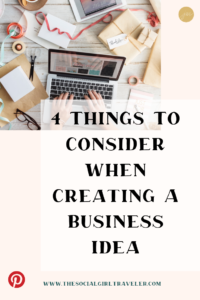Optimal success as an entrepreneur requires a solid foundation. Your professional goals should be set in a way that you know exactly what you are working towards and what it will take to get there.
When you set the foundation for your business, there are four questions that you need to think through; what is the structure of your business, what systems can you implement to support your work, are you solid in your mindset, and do you have a solid sales plan?
If you don’t have something you’re selling, you don’t have a business.
Each of these thought processes is going to take some time and should be covered separately.
For the sake of this article and hashing out some sold information, I will share some basic foundations for creating and structuring your business idea.
Understanding the structure of your own business means being able to speak to 5 key points:
 Who the client is and how to reach them
Who the client is and how to reach them
What need you can fill and how you are going to reach your customer
The outcome customers can expect from working with you or using your product
How the product/service is made available to others
1- The Client
The first step to setting the structure for your business is understanding who you are trying to reach and what their needs are. Get very specific on who your client is. Your ideal client should have a name, an age range, an income bracket, likes and dislikes, a personality, and is in some way in need of what service or product you intend to provide. Create an Avatar!
For example, if your audience is younger you will need to be adept at working through various social media platforms, whereas if your clients are older you may need to reach them through other outlets and platforms.
2- The Need
Knowing the nature of your ideal customer or client’s needs/problems is also important. Is your product or service of convenience? Is it an everyday necessity? Is it a one time purchase or an ongoing service or subscription? Is the need emotionally driven?
Every business exists because it meets a need or solves a problem for a specific audience.
If the need is pressing the customer might do a google search for this product or service. Or they might already have a product that’s a go-to for them. If a customer has a favorite laundry soap, what would make them choose something different? It’s a common need, and something your ideal client is probably already looking for on a regular basis. How are you going to appropriate market your product in a way that interrupts their normal search for that favorite go-to soap and convince them that yours fills their needs in a better way?
If it’s not as significant of a need and is a product or service that your customer doesn’t know about and doesn’t know the potential positive impact of what you have to offer, how are you going to find that customer and communicate that you have something that they would be able to use?
 3- Marketing
3- Marketing
Intuitively the next part of this is being able to communicate that once you fill the customer need- what is the positive outcome they can expect? To continue using the soap metaphor- are they going to use less and spend less but have cleaner clothes? If so, the customer needs to know that this is the benefits of using your product! Is your packaging biodegradable? If so, know your clients can take pride in being more earth-conscious!- This is something you should share in your brand story as 66% of global consumers are willing to pay more for sustainable goods.
Sharing the brand story is a crucial part of connecting with your consumer. We live in a time where people are constantly being sold to. How do you share a brand message with your customer than connects with them emotionally?
People don’t buy on facts, they buy on emotions.
4- The Availability
Is your product readily available to your customer? Do they have to go out of their way to find it? Think through how you are going to make this available and easily accessible. Selling a product or service is a challenge if the customer feels like they have to do a lot of work to get to it in the first place.
This is where systems should be put in place. Platforms like Shopify (for product sold goods) or Kajabi for online education services make, not only the consumer journey easy and accessible but the business owners too.
Once you’ve seriously thought about each of these key points, write down what the answers are and make sure that you can return to these notes to keep you focussed on how you are laying that foundation. Everything you do should align with your answers to these questions. Every business starts out as a thought and continues to expand in the mind before anything ever happens. Start out with a complete thought and make sure you really know who you are trying to reach and how you are going to do that.
Learning to create this foundation isn’t the easiest. I am hosting a FREE CHALLENGE for Creating Your Money Making Offer where you’ll receive the tools for creating an offer for dream customer.
P.S.- If you want a little more of one on one support come join my private Facebook community – Passionate + Purposeful Entrepreneurs, where we have Live training session every Wednesday on all things entrepreneurship, passion, and purpose.









Superb blog Jen, loved those 4 points which are key when creating a business.